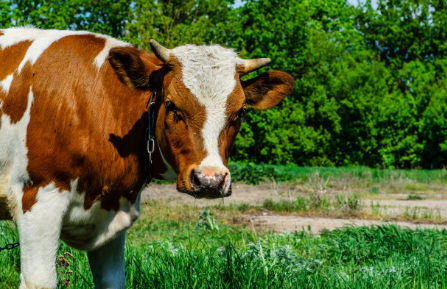
- Online pavilions:
- Veterinary medicines
- Veterinary raw materials
- Other
- Asia
- America
- medical instruments

News briefing: To raise cattle, we must first do a good job in the construction of the barn, and build a barn that is warm in winter and cool in summer according to local conditions. In winter, it is necessary to maintain heat preservation and keep the inside of the bar
To raise cattle, we must first do a good job in the construction of the barn, and build a barn that is warm in winter and cool in summer according to local conditions. In winter, it is necessary to maintain heat preservation and keep the inside of the barn above 5°C. Remove feces regularly every day, ventilate at noon, brush the body of the cow, and take it out of the house to bask in the sun regularly to enhance physical fitness and increase fat. An automatic manure scraper system can be used here, which can realize manure cleaning time control, manure cleaning cycle control, scraper stroke control, temperature control, manual control, etc.
Secondly, it is necessary to select good breed cattle. Choosing good breeds of cattle for breeding is the key to obtaining good benefits, because good breed cattle not only have good meat quality, fast growth, high feed remuneration, good appearance, and low morbidity. It is necessary to change the practice of progressive hybridization that has been used for many years, and actively introduce Limousin, Simmental and other varieties for three-way hybridization, and continuously improve the improvement effect and economic benefits. Don’t think that local cattle are already very good, and don’t pay attention to breed improvement. Keep improving the breeds you raise. Breed improvement should be done when the price of cattle is high, and breed improvement should be done when the price of cattle is low. If possible, we should promote freezing as much as possible. New technology of semen breeding. In particular, it should be noted that hybrid bulls cannot be used for breeding, because although hybrid bulls are tall and powerful, they are genetically unstable, which can easily cause inbreeding, degeneration of offspring, and low economic benefits. To
Its three scientific feedings. Raising cows should try their best to let the cows eat delicious and full green grass feed, while supplementing other necessary nutritious feeds. To improve the efficiency of raising cattle, we must start with the breeding of calves, especially the first and second winter and spring house feeding periods so that they can weigh up to 300 kg at the age of 18-24 months. After the intensive fattening, the body weight is more than 500 kg and is released. The crude protein content of rice straw and wheat straw can be increased after ammoniating, which can not only reduce feeding costs, but also increase the economic benefits of cattle raising. Therefore, it is necessary to vigorously popularize and popularize new straw treatment technologies such as straw silage, semi-dry storage and ammoniation. Raise cattle on straw. To
Fourth, we must do a good job in deworming and disease prevention. When cattle are grazing, they are often infected with various parasites in and out of their bodies due to their feeding on forages and contact with the ground. For example, Haemonchus contortus, esophagous nematodes and esophageal nematodes are prone to appear in the digestive tract of cattle; cattle are very susceptible to mites and ticks outside , Lice, flies, maggots and other ectoparasites. These parasites absorb nutrients and release toxins, which hinder the growth and development of cattle, which can reduce daily gain by 35% and feed conversion rate by 30%; cow fly maggots more than double the price of skin, and when the parasites are severe, they can cause death. It can be seen that deworming is an indispensable and important part of cattle raising. Farmers raising cattle can be dewormed twice in spring from March to May and autumn from September to October. Fattening cattle must be dewormed at the beginning of fattening. At present, there are many kinds of anthelmintic drugs, levamisole, trichlorfon, etc. can be used, but the anti-insect spectrum is narrow and the effect is not satisfactory. Afodin (worm buster) is the first choice for deworming. The drug is a broad-spectrum, high-efficiency, low-toxicity, new anti-parasitic veterinary drug developed and produced in recent years, which can simultaneously repel nematodes in livestock and poultry and parasites such as mites, ticks, lice, fly maggots, etc. in vitro. There are four dosage forms: injection, tablet, capsule and powder. Among them, the powder is moderately priced and easy to use. Usage and dosage: Administer or mix well and feed in the feed. Use 1 gram for every 10 kg of body weight. Deworming is best arranged in the afternoon or evening so that the worms will be excreted during the day the next day for easy collection and disposal. It is best to stop eating for 6-12 hours before administration, and have to drink water to improve the efficacy of the drug. After all kinds of parasites inside and outside the cattle are driven out, the effect of scientific breeding and fat increase is remarkable. Preventing cattle diseases is also one of the keys to achieving higher benefits in cattle raising. If disease prevention is not done well, breeding and feeding will give up all previous efforts. In order to prevent cattle diseases, in addition to cleaning and disinfecting cattle sheds and cattle bodies, ensuring hygiene and safety of cattle feed and drinking water, and deworming, cattle body brushes can be used for cleaning. If you don't have enough veterinary skills, you should keep in touch with the local veterinarian to prevent and treat diseases.